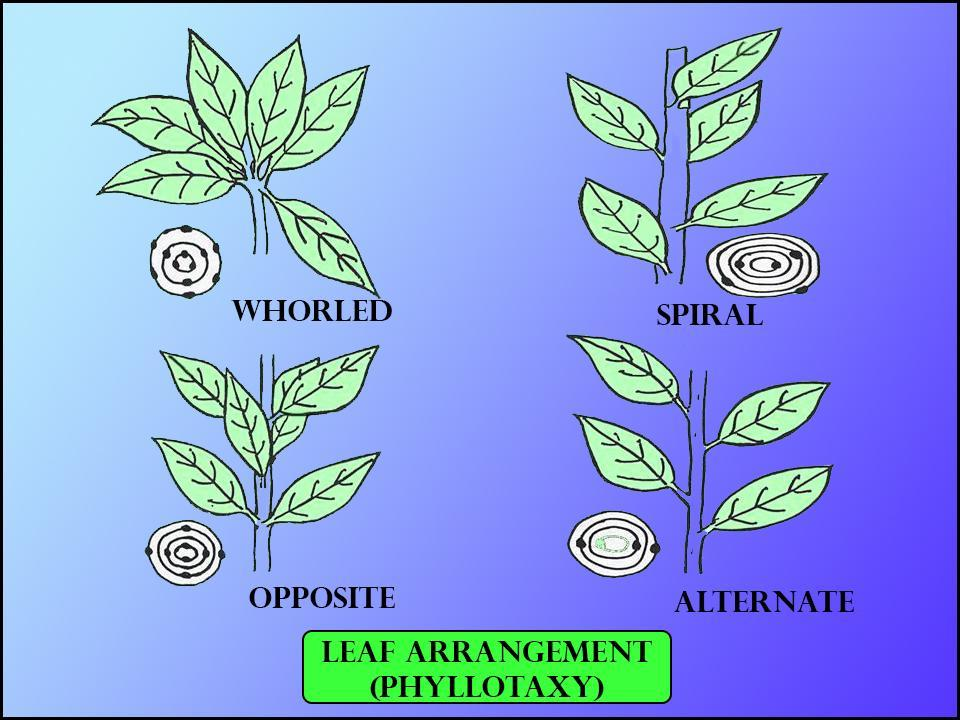
What term is given to the arrangement of leaves on the stem?
Answer
487.5k+ views
Hint: Leaves are attached to stems at nodes, where the leaf is an organ of vascular plants, and food making factories of green plants. Leaves come in many different shapes and sizes.
Complete answer:
- Phyllotaxy refers to the arrangement of leaves on the stem or branch. This is usually of three types- Alternate, opposite, and whorled.
- Alternate phyllotaxy
- In this type, a single leaf arises at each node.
- The leaves arise laterally on the stem or branches.
- Examples: Sunflower, mango, china rose, mustard, etc
- Opposite phyllotaxy
- In this type two leaves arise from each node in the opposite direction. It is of two types:
- Decussate: When one pair of the leaf is placed at a right angle to the next or lower pair of the leaf, it is said to be opposite the decussate phyllotaxy.
- Example: Calotropis, Ocimum
- Superposed: In this type, all the pairs of leaves on the stem are arranged one above the other.
- Example: Guava, Jamun
- Spiral: In this type leaves arise succeedingly around the stem.
- Whorled or verticillate phyllotaxy
- In this type, more than two leaves arise from each node and a whorl around it.
- Example: Nerium, Alstonia.

Additional Information:
- Most of the angiosperm has one leaf per node or alternate phyllotaxy with leaves arranged in a spiral.
- The angle between leaves is such that which minimizes the shading of lower leaves.
- Plants in the intense sun show opposite phyllotaxy which increases shedding and so water loss.
Note:
- Node: The part of the stem where one or more leaves are stitched.
- Internode: The region of the stem between two successive nodes.
Complete answer:
- Phyllotaxy refers to the arrangement of leaves on the stem or branch. This is usually of three types- Alternate, opposite, and whorled.
- Alternate phyllotaxy
- In this type, a single leaf arises at each node.
- The leaves arise laterally on the stem or branches.
- Examples: Sunflower, mango, china rose, mustard, etc
- Opposite phyllotaxy
- In this type two leaves arise from each node in the opposite direction. It is of two types:
- Decussate: When one pair of the leaf is placed at a right angle to the next or lower pair of the leaf, it is said to be opposite the decussate phyllotaxy.
- Example: Calotropis, Ocimum
- Superposed: In this type, all the pairs of leaves on the stem are arranged one above the other.
- Example: Guava, Jamun
- Spiral: In this type leaves arise succeedingly around the stem.
- Whorled or verticillate phyllotaxy
- In this type, more than two leaves arise from each node and a whorl around it.
- Example: Nerium, Alstonia.

Additional Information:
- Most of the angiosperm has one leaf per node or alternate phyllotaxy with leaves arranged in a spiral.
- The angle between leaves is such that which minimizes the shading of lower leaves.
- Plants in the intense sun show opposite phyllotaxy which increases shedding and so water loss.
Note:
- Node: The part of the stem where one or more leaves are stitched.
- Internode: The region of the stem between two successive nodes.
Recently Updated Pages
Master Class 11 Economics: Engaging Questions & Answers for Success

Master Class 11 Business Studies: Engaging Questions & Answers for Success

Master Class 11 Accountancy: Engaging Questions & Answers for Success

Master Class 11 English: Engaging Questions & Answers for Success

Master Class 11 Computer Science: Engaging Questions & Answers for Success

Master Class 11 Maths: Engaging Questions & Answers for Success

Trending doubts
Draw a diagram of nephron and explain its structur class 11 biology CBSE

Why was the Vernacular Press Act passed by British class 11 social science CBSE

Differentiate between calcination and roasting class 11 chemistry CBSE

A solution of a substance X is used for white washing class 11 chemistry CBSE

What is spore formation class 11 biology CBSE

Nastic movement differ from tropical movement in being class 11 biology CBSE




